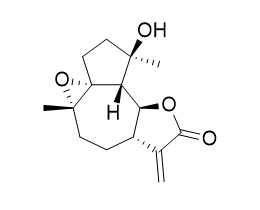Epoxymicheliolide
Epoxymicheliolide, a novelguaiane-type sesquiterpene lactone, inhibits NF‑κB/COX‑2 signaling pathways by targeting leucine 281 and leucine 25 in IKKβ in renal cell carcinoma, it may be a novel anticancer agent in the treatment of renal cell carcinoma.
Inquire / Order:
manager@chemfaces.com
Technical Inquiries:
service@chemfaces.com
Tel:
+86-27-84237783
Fax:
+86-27-84254680
Address:
1 Building, No. 83, CheCheng Rd., Wuhan Economic and Technological Development Zone, Wuhan, Hubei 430056, PRC
Providing storage is as stated on the product vial and the vial is kept tightly sealed, the product can be stored for up to
24 months(2-8C).
Wherever possible, you should prepare and use solutions on the same day. However, if you need to make up stock solutions in advance, we recommend that you store the solution as aliquots in tightly sealed vials at -20C. Generally, these will be useable for up to two weeks. Before use, and prior to opening the vial we recommend that you allow your product to equilibrate to room temperature for at least 1 hour.
Need more advice on solubility, usage and handling? Please email to: service@chemfaces.com
The packaging of the product may have turned upside down during transportation, resulting in the natural compounds adhering to the neck or cap of the vial. take the vial out of its packaging and gently shake to let the compounds fall to the bottom of the vial. for liquid products, centrifuge at 200-500 RPM to gather the liquid at the bottom of the vial. try to avoid loss or contamination during handling.
Chinese Journal of Tissue Engineering Research2024, 28(8):1149-1154.
Front Microbiol.2023, 14:921653.
Evid Based Complement Alternat Med.2021, 2021:8707280.
Int J Med Sci.2020, 17(5):626-631
Foods.2023, 12(6):1130.
J Nat Med.2018, 72(3):734-744
Biomed Pharmacother.2024, 181:117647.
Eur J Pharmacol.2024, 975:176644.
Food Funct.2022, 13(13):6923-6933.
J AOAC Int.2021, 104(6):1634-1651.
Related and Featured Products
International Journal of Oncology,2018,53(3).
Epoxymicheliolide, a novelguaiane-type sesquiterpene lactone, inhibits NF‑κB/COX‑2 signaling pathways by targeting leucine 281 and leucine 25 in IKKβ in renal cell carcinoma[Reference:
WebLink]
Parthenolide (PTL) is a sesquiterpene lactone compound obtained from Tanacetum parthenium (feverfew) and inhibits the activation of nuclear factor (NF)-κB. Epoxymicheliolide (EMCL) is a compound which is structurally related to PTL; however, EMCL is more stable under acidic and alkaline conditions. As a biologically active molecule, the detailed mechanism by which EMCL inhibits tumor activity remains to be elucidated.
METHODS AND RESULTS:
The present study evaluated the effect of EMCL on renal cell carcinoma (RCC) cells and identified the underlying mechanisms. It was found that treatment with EMCL significantly inhibited the proliferation of RCC cells in vitro and increased the induction of apoptosis by activating the mitochondria- and caspase-dependent pathway. Simultaneously, EMCL suppressed cell invasion and metastasis by inhibiting epithelial-mesenchymal transition, as observed in a microfluidic chip assay. Furthermore, using immunofluorescence analysis, an electrophoretic mobility shift assay and a dual-luciferase reporter assay, it was shown that treatment with EMCL significantly suppressed the expression of cyclooxygenase‑2 by inhibiting the translocation of NF‑κB p50/p65 and the activity of NF‑κB.
CONCLUSIONS:
Collectively, the results indicated that EMCL suppressed tumor growth by inhibiting the activation of NF‑κB and suggested that EMCL may be a novel anticancer agent in the treatment of RCC.



